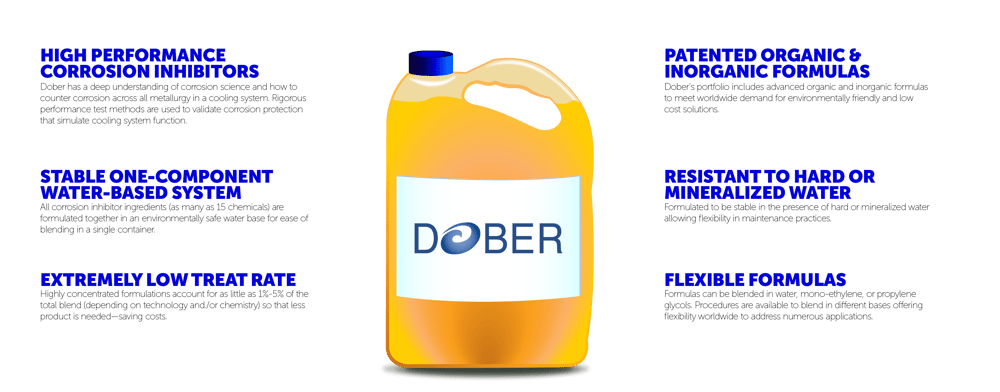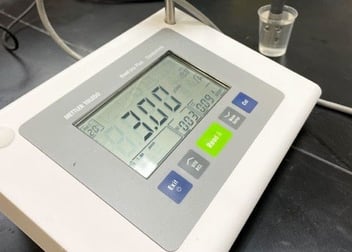Corrosion Inhibitor Technology
Dober is the leading technology in supplying corrosion inhibitor technology to Original Equipment Manufacturers (OEMs) globally. Dober also supplies to antifreeze blenders and recyclers.
Dober is proud to be the factory fill and aftermarket supplier for two major heavy-duty OEMs. Dober’s patented technology can be used in any antifreeze/coolant to provide optimum protection in any engine. This technology meets and exceeds all North American coolant standard specifications. 
Currently, Dober is working on new technology to meet European and Asian coolant standard specifications, such as Silicate Organic Acid Technology (Si-OAT) and Phosphate OAT. Dober is a member of the American Society for Testing and Materials (ASTM), Independent Lubricant Manufacturers Association (ILMA), An Association of Responsible Recyclers (NORA), Technology and Maintenance Council of American Trucking Association (TMC), and Society of Automotive Engineers (SAE).
Before we dive deeper, let’s define some terminology relevant to corrosion inhibitors and finished coolants overall.
Key Terms
Antifreeze
Antifreeze is made of ethylene or propylene glycol with up to 10% of corrosion protection. A coolant is made of an antifreeze and water. Most used coolant is 50% antifreeze and 50% water.
A coolant is designed to provide freezing and boiling protection and prevent corrosion. Coolant chemistry has changed over the past 20 years, including the use of different types of colors based on the OEM’s recommendation. Currently, we are seeing coolant dyed with yellow, blue, orange, red, green, fuchsia, pink and so on.
Water
Water is inexpensive and cannot be used as a coolant. Water can cause rust, corrosion and engine failure. Water has a lower boiling point, which can cause engine overheating. You can add water into the coolant, but you need keep the right glycol concentration to provide freezing protection in the winter.
Glycol
Glycol can be ethylene or propylene glycol. The difference between the two is that propylene glycol has a low toxicity, which is also found in the cosmetics and personal care products.
Glycol is added to water to withstand freezing temperatures and to raise the boiling point so the engine stays cool during operation. Ethylene glycol is perhaps the most common because it has better heat exchange properties than propylene glycol. Nothing would happen if propylene glycol is topped off with ethylene glycol, as it would change the freeze point only slightly. You need to correct the freeze point by using a refractometer for accuracy.
Mixing Coolant: Avoid if Possible
Mixing coolant formulations will reduce corrosion protection and will cause corrosion problem and inhibitors dropout in the coolant, which causes plugging and inadequate corrosion protection. Mixing coolants cannot be prevented when you top off your coolant at your local quick lube shop.
Engine manufacturers recommend mixing coolants should not exceed 25% limit. Over the 25% threshold, the recommendation is to drain, flush and refill with a fresh, new coolant.
Dober Offers Conventional, Hybrid and Organic Technologies
Conventional, also called IAT (Inorganic Additives Technology – Dober FCA)
This chemistry can be used in auto, light-duty (LD) and heavy-duty (HD) vehicles.
No maintenance is required in the auto or LD. However, in the HD applications, it needs to be maintained periodically (25,000 miles) by adding Supplemental Coolant Additives (SCAs) to the coolant to protect the engine metals (copper, solder, brass, steel, cast iron and aluminum) from corrosion, cavitation-erosion (liner pitting) and scale.
The service life of IAT is about 200,000 miles.
This is an inexpensive formulation. We also call this chemistry a fully formulated chemistry because it does not require an initial change of the SCAs.
Hybrid Technology (HOAT – Dober ACA)
This is a combination of conventional and organic acid technology — it has a longer service life of up to 60,000 miles. HOAT also does require SCAs, although less than IAT.
Organic Acid Technology (OAT - Dober OCA, WCA, and D-16)
This is defined as Extended Life Coolant (ELC).
This chemistry is used for HD applications, with some being Nitrited Organic Acid (NOAT), Nitrite/Molybdate Organic Acid Technology (NMOAT), or Nitrite-, Amine-, Phosphate-, Silicate-free (NAPS) chemistry.
This chemistry is used due to more aluminum in a diesel engine. Since 2010, service managers and fleet owners have seen white residue plugging coolant filters and radiator tubes and coating cylinder liners because of nitrited coolant.
Now, we are seeing OEMs using more aluminum in Class 8 engines and less steel to improve fuel efficiency and reduce emissions. Coolant with Nitrite OAT reacts with the flux used to braze aluminum parts together. That reaction changes the coolant’s acidity, increases metal corrosion and leads to undissolved solid and residue that plug filters, coat heat exchangers and cause scale on the cylinder liners. This reaction can prevent heat from escaping.
Why Dober Does NOT offer an approved OEM’s Coolant
OEMs only can provide approvals on coolant brand names. Dober Chemical does not offer a coolant brand name into the aftermarket. Dober offers a state-of-the-art, economical corrosion inhibitor (syrup) to blenders to market their own brands of antifreeze/coolant.
We have seen blenders receive approvals on their coolants by using Dober’s corrosion inhibitor technology, meeting Cummins, CAT and Detroit coolant specifications.
Dober will not enter the market with a Dober brand name and does not want to compete with Dober’s loyal customers.
Bottom line: Dober does not make the finished ICE coolant, but it makes them better through its corrosion inhibitor technology.
If you’d like to learn more about our products and our corrosion inhibitor technology, drop us a line.

.png?width=352&name=PFD%20-%20Product%20Page%20-EV%20SLC%20(2).png)

